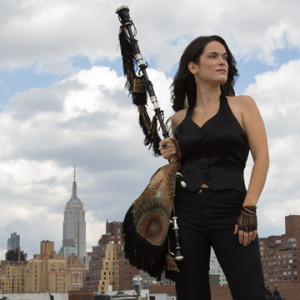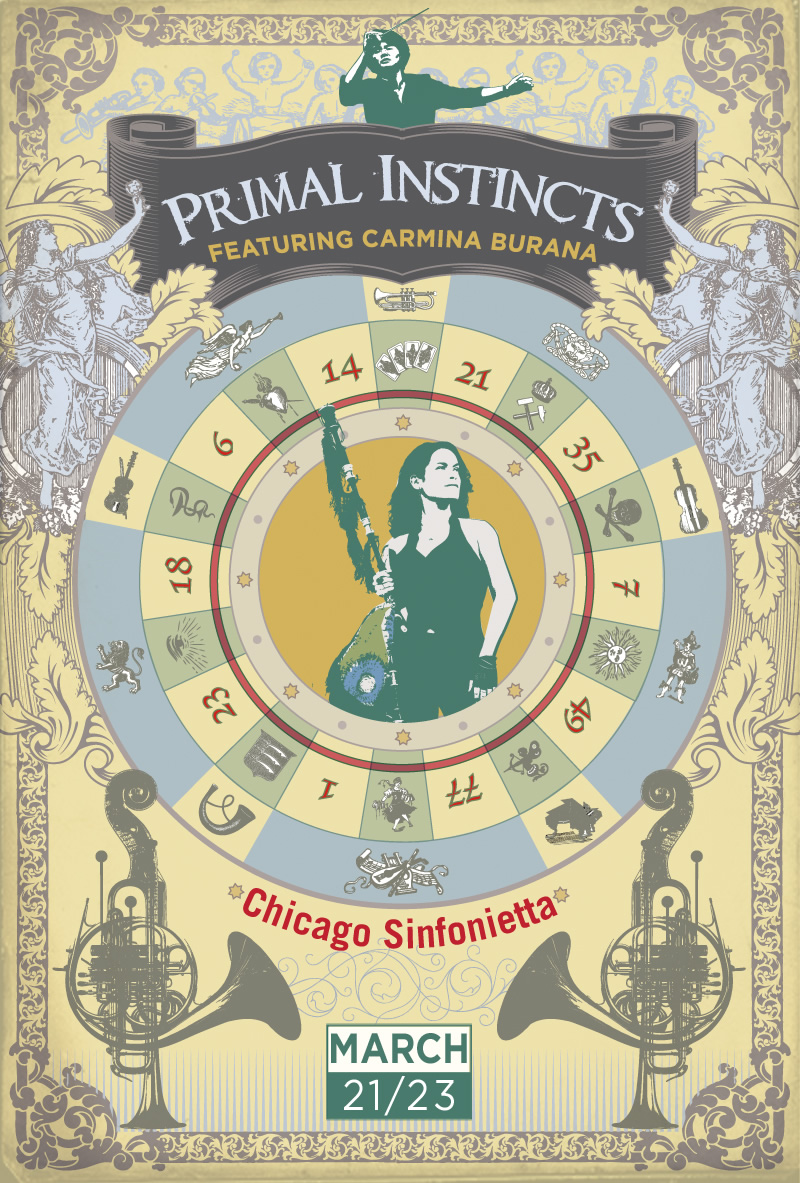
Primal. As a word, it’s practically an antonym for refined. So what could possibly be primal about a classical music concert? Of course, art springs from our very soul. Even when exquisitely crafted, the impulse to create lies deep within, beyond the rational. This concert delves into the depths of our souls to find the messy human impulses that live in us all. Prepare for Primal Instincts.
ARTISTS
- Mei-Ann Chen
- Cristina Pato
- Roosevelt University CCPA Conservatory Chorus
- Anima – Young Singers of Greater Chicago
- Kimberly Jones
- Jonathan Weyant
- Joseph Lattanzi
Mei-Ann Chen, Music Director and conductor
 Mei-Ann Chen is well into her fourth season as Chicago Sinfonietta Music Director. In her short time with the orchestra, she has brought the orchestra to new artistic heights, developing an aggressively adventurous approach to repertoire and collaboration while firmly anchoring her ambitious plans in the Sinfonietta’s quarter-century heritage of diversity, inclusion and service to the community. In the process, she has earned two awards from the League of American Orchestra: The Helen M. Thompson Award, given to a music director every two years to recognize their impact and potential for a significant national career, and one for the orchestra, a First Place Award for Adventurous Programming.
Mei-Ann Chen is well into her fourth season as Chicago Sinfonietta Music Director. In her short time with the orchestra, she has brought the orchestra to new artistic heights, developing an aggressively adventurous approach to repertoire and collaboration while firmly anchoring her ambitious plans in the Sinfonietta’s quarter-century heritage of diversity, inclusion and service to the community. In the process, she has earned two awards from the League of American Orchestra: The Helen M. Thompson Award, given to a music director every two years to recognize their impact and potential for a significant national career, and one for the orchestra, a First Place Award for Adventurous Programming.
It’s an approach that has elicited remarks like this one from the Chicagoist blog: “We love Chicago Sinfonietta’s approach to classical music: it really opens it up to a new audience and makes it approachable and interesting.”
Born in Taiwan, Ms. Chen has lived in the United States since 1989. She holds a Doctor of Musical Arts degree in conducting from the University of Michigan, where she was a student of Kenneth Kiesler. Prior to that, she was the first student in New England Conservatory’s history to receive master’s degrees, simultaneously, in both violin and conducting. She is also the Music Director of the Memphis Symphony Orchestra and is in high demand around the globe as a guest conductor.
Mei-Ann Chen’s complete biography can be found here.
Cristina Pato, gaita
The gaita is a kind of bagpipe. Yes, bagpipe. And while that word may conjure an image of bearded men in kilts, Cristino Pato is definitely not one of those. First of all, she hails from the Galician coast of Spain, a region that the Celts ruled almost two millennia ago, before, in fact, they had crossed the channel into Britain. In the Iberian Peninsula, the Celts mingled with other ethnic groups, and thus (to make a long story short) you have several, shall we say, hotter traditions like flamenco and Arabic music in the mix. Ms. Pato takes this even further, incorporating sounds from around the world.
Hailed by The Wall Street Journal as “one of the living masters of the gaita," bagpiper, pianist and composer Cristina Pato enjoys an active professional career devoted to Galician popular and classical music and jazz, and her dual careers have led to performances on major stages throughout Europe, USA, India, Africa and China. She has collaborated with the likes of Yo-Yo Ma, Latin jazz masters Arturo O’Ferril and Paquito Rivera, and Argentine composer Osvaldo Golijov.
As you might surmise from that brief resume, Cristina Pato’s music is eclectic and energetic. She recently performed for WNYC’s Soundcheck and the video is from that broadcast.
She also has a website covering all facets of her career.
Roosevelt University CCPA Conservatory Chorus - Cheryl Frazes Hill, Director
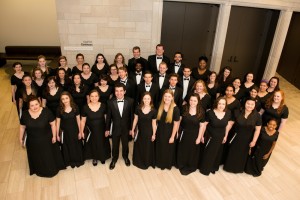 We are pleased to welcome back the CCPA (Chicago College of Performing Arts) Conservatory Chorus. You may remember them from our January 2014 MLK tribute concert, where they contributed to the dramatic performance of Jacob TV’s Mountain Top.
We are pleased to welcome back the CCPA (Chicago College of Performing Arts) Conservatory Chorus. You may remember them from our January 2014 MLK tribute concert, where they contributed to the dramatic performance of Jacob TV’s Mountain Top.
The Conservatory Choral program provides students with exposure to many styles of choral repertoire. Consisting of undergraduate voice and music education majors, the Conservatory Chorus collaborates with instrumental ensembles regularly in performances of larger symphonic choral works. Associate Professor Cheryl Frazes Hill has served as Director of Choral Activities and Head of Music Education at Roosevelt University’s Chicago College of Performing Arts since 2001. Under her direction, the Conservatory Chorus has been selected to prestigious events including an appearance in the American Choral Directors Association National Convention, the Illinois Music Educators State Conference, guest appearances with regional professional orchestras and with the Rolling Stones at the United Center singing the iconic intro and conclusion to You Can’t Always Get What You Want.
Yes, the Rolling Stones. For a shaky-camera homemade glimpse of the Chorus performing in front of a very large and extremely enthusiastic audience, check the video. Most of the choral action is at the beginning and at the 6:30 mark.
For an account on how the Chorus prepared for and performed this unusually high profile gig, read this RedEye article.
Anima – Young Singers of Greater Chicago Emily Ellsworth, Artistic Director
 Anima means breath, life, soul and spirit. Anima’s four ensembles, ranging from introductory to advanced, are open to boys and girls grades K-12. In after-school rehearsals students learn to read music, sing music from many cultures and genres, participate in a confidence and character-building culture, sing with Chicago’s major musical organizations, and make lifelong friends. Founded in 1964 as the Glen Ellyn Children’s Chorus, Anima is an internationally recognized youth choral organization located in Glen Ellyn, IL, serving youth throughout the Chicagoland area. Anima’s mission is to transform young lives through excellence in music education and choral singing.
Anima means breath, life, soul and spirit. Anima’s four ensembles, ranging from introductory to advanced, are open to boys and girls grades K-12. In after-school rehearsals students learn to read music, sing music from many cultures and genres, participate in a confidence and character-building culture, sing with Chicago’s major musical organizations, and make lifelong friends. Founded in 1964 as the Glen Ellyn Children’s Chorus, Anima is an internationally recognized youth choral organization located in Glen Ellyn, IL, serving youth throughout the Chicagoland area. Anima’s mission is to transform young lives through excellence in music education and choral singing.
Like the Roosevelt University CCPA Conservatory Chorus, Anima is no stranger to the Sinfonietta stage, having joined us on Holst’s The Planets in our historic 2008 Millennium Park concert.
Anima’s website has plenty of information on the history of the organization and their programs. In keeping with the spirit of Bizet’s Les Toréadors, enjoy this video of Anima singing from a bullring in Spain.
Kimberly Jones, soprano
 Kimberly Jones is an alumnus of the Ryan Opera Center with Lyric Opera of Chicago. There she portrayed roles such as Xenia in Boris Godunov, Pedro in Don Quichotte and Despina in Cosi fan tutte student matinees. She also performed at Grant Park as Zerlina in Don Giovanni and Adele in Die Fledermaus. She sang the role of Clara in Houston Grand Opera's Porgy and Bess, which graced the stages of La Scala, the Bastille, Tokyo (Bunkamura), San Francisco, Seattle and many other cities. With Lyric Opera she returned as Margru in the world premiere of Anthony Davis' Amistad, and with the Lyric Opera in the Neighborhoods, portrayed the title roles of Cenerentola and Rosina in Barber of Seville. She has performed in France, Italy and Germany and locally at Rockefeller Chapel, Preston Bradley Hall and Symphony Center.
Kimberly Jones is an alumnus of the Ryan Opera Center with Lyric Opera of Chicago. There she portrayed roles such as Xenia in Boris Godunov, Pedro in Don Quichotte and Despina in Cosi fan tutte student matinees. She also performed at Grant Park as Zerlina in Don Giovanni and Adele in Die Fledermaus. She sang the role of Clara in Houston Grand Opera's Porgy and Bess, which graced the stages of La Scala, the Bastille, Tokyo (Bunkamura), San Francisco, Seattle and many other cities. With Lyric Opera she returned as Margru in the world premiere of Anthony Davis' Amistad, and with the Lyric Opera in the Neighborhoods, portrayed the title roles of Cenerentola and Rosina in Barber of Seville. She has performed in France, Italy and Germany and locally at Rockefeller Chapel, Preston Bradley Hall and Symphony Center.
She is the co-founder of a new soprano trio, Tres Belle, with fellow sopranos Leila Bowie and Marisa Buchheit. The soprano trio recently appeared in educational performances for the Ravinia Festival. Ms. Jones is on the voice faculty of Merit School of Music, Columbia College and Sherwood School of Music.
Her most recent performance was with the South Shore Opera Company in Chicago where she did a mixed program that included Verdi arias, Andre Previn’s Honey and Rue and the spiritual He’s Got the Whole World in His Hands.
A more detailed biography, including audio clips, can be found at the Classical Singer website. One of her favorite pastimes is singing the national anthem for the Chicago Bulls, which she does in this video. Enjoy!
Jonathan Weyant, tenor
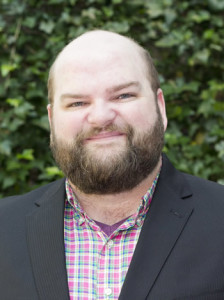 Jonathan Weyant, tenor, was recently accepted into the Professional Diploma in Opera degree program at the Chicago College of Performing Arts, Roosevelt University for the Fall 2015. He will also be a Young Artist with Chicago Opera Theatre starting beginning in the fall at Harris Theatre. He completed his master’s degree at Roosevelt University – CCPA in May 2013. While at CCPA, he performed the roles of Il Tinco (Il Tabarro), Theseus (L’Abandon d’Ariane, La Delivrance de Thesee – Mihaud), Commanding Officer/Government Official in the Chicago premier of Daron Hagen’s Amelia, 2nd Priest (Die Zauberflöte) and covered Candide (Candide). In the summer of 2012, he was a featured performer at the Tuscia Opera Festival in Viterbo, Italy. There, Mr. Weyant performed in the role of Ferrando (Così fan tutte), covered Rinuccio (Gianni Schicchi), and was the tenor soloist for Mozart’s Coronation Mass. A native of Scottsdale, AZ, Mr. Weyant received his Bachelor of Arts from Arizona State University.
Jonathan Weyant, tenor, was recently accepted into the Professional Diploma in Opera degree program at the Chicago College of Performing Arts, Roosevelt University for the Fall 2015. He will also be a Young Artist with Chicago Opera Theatre starting beginning in the fall at Harris Theatre. He completed his master’s degree at Roosevelt University – CCPA in May 2013. While at CCPA, he performed the roles of Il Tinco (Il Tabarro), Theseus (L’Abandon d’Ariane, La Delivrance de Thesee – Mihaud), Commanding Officer/Government Official in the Chicago premier of Daron Hagen’s Amelia, 2nd Priest (Die Zauberflöte) and covered Candide (Candide). In the summer of 2012, he was a featured performer at the Tuscia Opera Festival in Viterbo, Italy. There, Mr. Weyant performed in the role of Ferrando (Così fan tutte), covered Rinuccio (Gianni Schicchi), and was the tenor soloist for Mozart’s Coronation Mass. A native of Scottsdale, AZ, Mr. Weyant received his Bachelor of Arts from Arizona State University.
Jonathan Weyant has a Soundcloud page where you can hear several examples of his singing. The video features him in recital.
Joseph Lattanzi, baritone
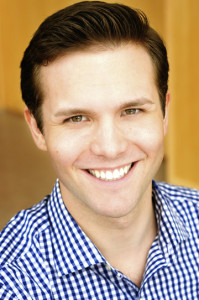 American baritone Joseph Lattanzi is gaining notice for his “robust vocalism,” “unmistakable charisma,” and “undeniable star potential.” He has criss-crossed the United States with attention getting performances for opera companies in Seattle, San Francisco, Atlanta and Cincinnati, appearing in classic works like Carmen, Le Nozze di Figaro and Madama Butterfly as well as contemporary works such as Gregory Spears' new opera Fellow Travelers and Dominick Argento’s Postcard from Morocco. In addition to performing Carmina Burana here, his 2014-15 schedule includes Jake Heggie’s new opera Great Scott, revisiting Fellow Travelers at the Opera America National Opera Center, and performing Guglielmo in Così fan tutte.
American baritone Joseph Lattanzi is gaining notice for his “robust vocalism,” “unmistakable charisma,” and “undeniable star potential.” He has criss-crossed the United States with attention getting performances for opera companies in Seattle, San Francisco, Atlanta and Cincinnati, appearing in classic works like Carmen, Le Nozze di Figaro and Madama Butterfly as well as contemporary works such as Gregory Spears' new opera Fellow Travelers and Dominick Argento’s Postcard from Morocco. In addition to performing Carmina Burana here, his 2014-15 schedule includes Jake Heggie’s new opera Great Scott, revisiting Fellow Travelers at the Opera America National Opera Center, and performing Guglielmo in Così fan tutte.
And then there’s this from the San Francisco Chronicle: "Baritone Joseph Lattanzi was superb... unmistakable charisma... The two numbers at the beginning of Act 3, which found him moving from oily seductiveness to explosive rage, made a vocal and theatrical tour de force.”
More about Lattanzi can be found on his website.
COMPOSERS
Music from Carmen: Habanera and Les Toréadors

Georges Bizet was a French composer of the romantic era. Best known for his operas in a career cut short by an early death, Bizet achieved few successes before his final work, Carmen, which has become one of the most popular and frequently performed works in the entire opera repertoire. Even if you are not a fan of opera and think you’ve never heard the music from Carmen, trust me, you have, at the very least, heard the Habanera. It has found its way into such films as Trainspotting and Magnolia. It’s also possible that you know that word as the name of a particularly fiery chili pepper. In all likelihood, this is not a coincidence.
The opera tells the story of the downfall of Don José, a soldier who is seduced by the fiery Gypsy, Carmen. José abandons his childhood sweetheart and deserts his duties for her, yet loses Carmen's love to the glamorous toreador Escamillo, after which José kills her in a jealous rage. (Talk about your primal instincts!) Carmen proved so popular that it was later arranged as an orchestral suite, and these two short movements of this tragic tale set the mood for what is to follow.
The Encyclopedia Britannica has a good overview of Bizet’s life and work. To hear the Habanera, check the video.
A Galician Voyage: Concerto for Bagpipes, Piano & Orchestra
 Composer/pianist/bandleader Emilio Solla was born in Mendoza, Argentina. He was educated at National Conservatory of Music in Buenos Aires and moved to Barcelona in 1996 and then on to New York City (where Cristina Pato is also based) in 2006, where he received an MA in Jazz Composition at the Aaron Copland School of Music. Much like fellow countryman Astor Piazzolla did decades earlier when he invented tango nuevo, Solla’s music combines rigorous classical training with the tango of his homeland and jazz improvisation, moving seamlessly among the three. He leads jazz ensembles in both New York and Europe and produced Cristina Pato’s latest album, Migrations.
Composer/pianist/bandleader Emilio Solla was born in Mendoza, Argentina. He was educated at National Conservatory of Music in Buenos Aires and moved to Barcelona in 1996 and then on to New York City (where Cristina Pato is also based) in 2006, where he received an MA in Jazz Composition at the Aaron Copland School of Music. Much like fellow countryman Astor Piazzolla did decades earlier when he invented tango nuevo, Solla’s music combines rigorous classical training with the tango of his homeland and jazz improvisation, moving seamlessly among the three. He leads jazz ensembles in both New York and Europe and produced Cristina Pato’s latest album, Migrations.
Galician Voyage was commissioned by Cristina Pato along with New Music USA as part of her ongoing project to create a body of work for gaita and orchestra. It received its world premiere with the Orquestra Simfònica del Vallès in Barcelona a mere 5 months ago. The Sinfonietta performance is its United States premiere.
The video is a mini-documentary on the making of Emilio Solla’s newest album Second Half with his New York based jazz ensemble La Inestable de Brooklyn.
Solla has a website as well.
Carmina Burana
 Like the Habanera from Carmen, it’s quite likely that you’ve heard at least a bit of Carmina Burana, as parts of it have found its way into several movie scores, often setting the mood for dramatic or cataclysmic situations. Upon hearing it, you might have imagined an ancient vista of thousands of medieval monks chanting under a stormy sky. Although the texts sung by massive choirs are indeed based on medieval sources, the music itself is actually quite modern. Written by the German composer Carl Orff, it only dates to the 1930s and owes much to such stark modernists as Stravinsky. You might assume those Latin texts are religious in origin, but they are in fact quite secular, covering the fickleness of fortune and wealth, the ephemeral nature of life, the joy of the return of Spring, and the pleasures and perils of drinking, gluttony, gambling and lust.
Like the Habanera from Carmen, it’s quite likely that you’ve heard at least a bit of Carmina Burana, as parts of it have found its way into several movie scores, often setting the mood for dramatic or cataclysmic situations. Upon hearing it, you might have imagined an ancient vista of thousands of medieval monks chanting under a stormy sky. Although the texts sung by massive choirs are indeed based on medieval sources, the music itself is actually quite modern. Written by the German composer Carl Orff, it only dates to the 1930s and owes much to such stark modernists as Stravinsky. You might assume those Latin texts are religious in origin, but they are in fact quite secular, covering the fickleness of fortune and wealth, the ephemeral nature of life, the joy of the return of Spring, and the pleasures and perils of drinking, gluttony, gambling and lust.
Carmina Burana is indeed a massive work. It is scored for an extra large orchestra and its choral section employs both adult and children’s choirs. There are also no less than three operatic soloists, one of whom is called upon to express the agony of a roasting swan. Upon its completion, Orff is said to have declared “Everything I have written to date… can be destroyed. With Carmina Burana, my collected works begin.”
The Orff website is a thorough guide to the composer and his works and is available in several languages. The video is the dramatic opening movement of the work, O Fortuna, complete with lyrics in Latin and English.
Research and copywriting by Don Macica.
Don is a marketing consultant to the performing arts community and a contributing writer to several online publications including Chicagomusic.org and Arteyvidachicago.com. When not traveling, he lives a stone's throw from Lake Michigan in Chicago’s Rogers Park neighborhood. He is the author of Border Radio, a blog about music, migration and cultural exchange.

